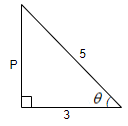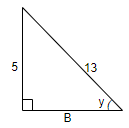
If $\cos \left( \alpha +\beta \right)=\dfrac{3}{5},\sin \left( \alpha -\beta \right)=\dfrac{5}{13}\text{ and }0<\alpha ,\beta <\dfrac{\pi }{4}$ then $\tan \left( 2\alpha \right)$ is equal to:
$\begin{align}
& a.\dfrac{21}{16} \\
& b.\dfrac{63}{52} \\
& c.\dfrac{33}{52} \\
& d.\dfrac{63}{16} \\
\end{align}$
Answer
574.2k+ views
Hint: Here, we consider $\alpha +\beta $ as one angle and $\alpha -\beta $ as another angle. We will use formula of $\tan \left( x+y \right)=\dfrac{\tan x+\tan y}{1-\tan x\tan y}$ to find the value of required trigonometric expression. Here, we will take $x=\alpha +\beta \text{ and }y=\alpha -\beta $, so we will get $x+y=\alpha +\beta +\alpha -\beta =2\alpha $ which is needed. Also, as $\alpha ,\beta $ lies in interval $\left( 0,\dfrac{\pi }{4} \right)$ it helps in determining quadrant of $\alpha +\beta $ and $\alpha -\beta $. Apart from these, we need to find $\tan x=\tan \left( \alpha +\beta \right),\tan y=\tan \left( \alpha -\beta \right)$ which can be calculated using the Pythagoras theorem.
Complete step by step answer:
In this question, we will use the concept o trigonometry. So, let us consider $\alpha +\beta $ as $\theta $ and $\alpha -\beta $ as y, so we get the given data, $\cos \left( \alpha +\beta \right)=\dfrac{3}{5},\sin \left( \alpha -\beta \right)=\dfrac{5}{13}$ as $\cos \theta =\dfrac{3}{5},\sin y=\dfrac{5}{13}$. Now, by using the basic formula, that is, we know that $\cos \theta =\dfrac{\text{Base}}{\text{Hypotenuse}}\text{ and sin}\theta \text{=}\dfrac{\text{Perpendicular}}{\text{Hypotenuse}}$.
Now, we will consider $\cos \theta =\dfrac{3}{5}$, keeping in mind that $\theta =\alpha +\beta $. So, we can draw the right angled triangle as follows.

So, here, we can apply the Pythagoras theorem, that is $Hypotenus{{e}^{2}}=Bas{{e}^{2}}+Perpendicula{{r}^{2}}$, and here we have the base = 3 and the hypotenuse = 5. So we can write,
$\begin{align}
& {{\left( 5 \right)}^{2}}={{\left( 3 \right)}^{2}}+{{P}^{2}} \\
& 25=9+{{P}^{2}} \\
& {{P}^{2}}=25-9=16 \\
& P=\pm 4 \\
\end{align}$
Now, we know that length cannot be negative, so we will neglect the negative sign. Hence, we get,
Perpendicular, P = 4
And we know that $\tan \theta =\dfrac{\text{Perpendicular}}{\text{Base}}$, so on substituting the values of perpendicular = 4 and base = 3, we get,
$\tan \theta =\dfrac{4}{3}$
Now we will consider $\sin y=\dfrac{5}{13}$ where $y=\alpha -\beta $. So, we get the figure as,

Now, using the Pythagoras theorem, that is $Hypotenus{{e}^{2}}=Bas{{e}^{2}}+Perpendicula{{r}^{2}}$, where hypotenuse = 13 and perpendicular = 5, we get,
$\begin{align}
& {{\left( 13 \right)}^{2}}={{\left( 5 \right)}^{2}}+{{B}^{2}} \\
& 169=25+{{B}^{2}} \\
& {{B}^{2}}=169-25=144 \\
& B=\pm 12 \\
\end{align}$
Now, we know that length cannot be negative, so we will neglect the negative sign. Hence, we get,
Base, B = 12
And we know that $\tan y=\dfrac{\text{Perpendicular}}{\text{Base}}$, so on substituting the values of perpendicular = 5 and base = 12, we get,
$\tan y=\dfrac{5}{12}$
Now, we know that $\tan \left( \theta +y \right)=\dfrac{\tan \theta +\tan y}{1-\tan \theta \tan y}$, so on substituting $\theta =\alpha +\beta ,y=\alpha -\beta ,\tan \theta =\dfrac{4}{3},\tan y=\dfrac{5}{12}$ in the above equation, we will get,
\[\tan \left( \alpha +\beta +\alpha -\beta \right)=\dfrac{\dfrac{4}{3}+\dfrac{5}{12}}{1-\dfrac{4}{3}\times \dfrac{5}{12}}\]
On solving it further, we get,
\[\begin{align}
& \tan \left( 2\alpha \right)=\dfrac{\dfrac{48+15}{36}}{\dfrac{36-20}{36}}=\dfrac{\dfrac{63}{36}}{\dfrac{16}{36}}=\dfrac{63}{16} \\
& \tan \left( 2\alpha \right)=\dfrac{63}{16}=3.9375 \\
\end{align}\]
Therefore, we get $\tan \left( 2\alpha \right)=\dfrac{63}{16}$.
So, the correct answer is “Option D”.
Note: As we can see that $0<\alpha ,\beta <\dfrac{\pi }{4}$ is also an important condition which cannot be neglected, as we know the quadrant rule that, in the first quadrant, all the trigonometric ratios are positive and in other three quadrants there is variance. So, this condition is verified in the given question.
Complete step by step answer:
In this question, we will use the concept o trigonometry. So, let us consider $\alpha +\beta $ as $\theta $ and $\alpha -\beta $ as y, so we get the given data, $\cos \left( \alpha +\beta \right)=\dfrac{3}{5},\sin \left( \alpha -\beta \right)=\dfrac{5}{13}$ as $\cos \theta =\dfrac{3}{5},\sin y=\dfrac{5}{13}$. Now, by using the basic formula, that is, we know that $\cos \theta =\dfrac{\text{Base}}{\text{Hypotenuse}}\text{ and sin}\theta \text{=}\dfrac{\text{Perpendicular}}{\text{Hypotenuse}}$.
Now, we will consider $\cos \theta =\dfrac{3}{5}$, keeping in mind that $\theta =\alpha +\beta $. So, we can draw the right angled triangle as follows.

So, here, we can apply the Pythagoras theorem, that is $Hypotenus{{e}^{2}}=Bas{{e}^{2}}+Perpendicula{{r}^{2}}$, and here we have the base = 3 and the hypotenuse = 5. So we can write,
$\begin{align}
& {{\left( 5 \right)}^{2}}={{\left( 3 \right)}^{2}}+{{P}^{2}} \\
& 25=9+{{P}^{2}} \\
& {{P}^{2}}=25-9=16 \\
& P=\pm 4 \\
\end{align}$
Now, we know that length cannot be negative, so we will neglect the negative sign. Hence, we get,
Perpendicular, P = 4
And we know that $\tan \theta =\dfrac{\text{Perpendicular}}{\text{Base}}$, so on substituting the values of perpendicular = 4 and base = 3, we get,
$\tan \theta =\dfrac{4}{3}$
Now we will consider $\sin y=\dfrac{5}{13}$ where $y=\alpha -\beta $. So, we get the figure as,

Now, using the Pythagoras theorem, that is $Hypotenus{{e}^{2}}=Bas{{e}^{2}}+Perpendicula{{r}^{2}}$, where hypotenuse = 13 and perpendicular = 5, we get,
$\begin{align}
& {{\left( 13 \right)}^{2}}={{\left( 5 \right)}^{2}}+{{B}^{2}} \\
& 169=25+{{B}^{2}} \\
& {{B}^{2}}=169-25=144 \\
& B=\pm 12 \\
\end{align}$
Now, we know that length cannot be negative, so we will neglect the negative sign. Hence, we get,
Base, B = 12
And we know that $\tan y=\dfrac{\text{Perpendicular}}{\text{Base}}$, so on substituting the values of perpendicular = 5 and base = 12, we get,
$\tan y=\dfrac{5}{12}$
Now, we know that $\tan \left( \theta +y \right)=\dfrac{\tan \theta +\tan y}{1-\tan \theta \tan y}$, so on substituting $\theta =\alpha +\beta ,y=\alpha -\beta ,\tan \theta =\dfrac{4}{3},\tan y=\dfrac{5}{12}$ in the above equation, we will get,
\[\tan \left( \alpha +\beta +\alpha -\beta \right)=\dfrac{\dfrac{4}{3}+\dfrac{5}{12}}{1-\dfrac{4}{3}\times \dfrac{5}{12}}\]
On solving it further, we get,
\[\begin{align}
& \tan \left( 2\alpha \right)=\dfrac{\dfrac{48+15}{36}}{\dfrac{36-20}{36}}=\dfrac{\dfrac{63}{36}}{\dfrac{16}{36}}=\dfrac{63}{16} \\
& \tan \left( 2\alpha \right)=\dfrac{63}{16}=3.9375 \\
\end{align}\]
Therefore, we get $\tan \left( 2\alpha \right)=\dfrac{63}{16}$.
So, the correct answer is “Option D”.
Note: As we can see that $0<\alpha ,\beta <\dfrac{\pi }{4}$ is also an important condition which cannot be neglected, as we know the quadrant rule that, in the first quadrant, all the trigonometric ratios are positive and in other three quadrants there is variance. So, this condition is verified in the given question.
Recently Updated Pages
Two men on either side of the cliff 90m height observe class 10 maths CBSE

What happens to glucose which enters nephron along class 10 biology CBSE

Cutting of the Chinese melon means A The business and class 10 social science CBSE

Write a dialogue with at least ten utterances between class 10 english CBSE

Show an aquatic food chain using the following organisms class 10 biology CBSE

A circle is inscribed in an equilateral triangle and class 10 maths CBSE

Trending doubts
Why is there a time difference of about 5 hours between class 10 social science CBSE

Write a letter to the principal requesting him to grant class 10 english CBSE

What is the median of the first 10 natural numbers class 10 maths CBSE

The Equation xxx + 2 is Satisfied when x is Equal to Class 10 Maths

Which of the following does not have a fundamental class 10 physics CBSE

State and prove converse of BPT Basic Proportionality class 10 maths CBSE




